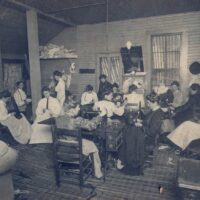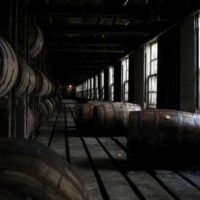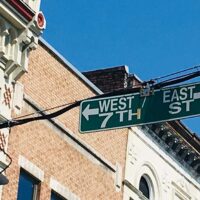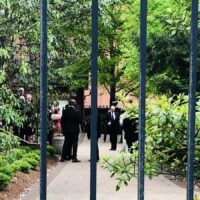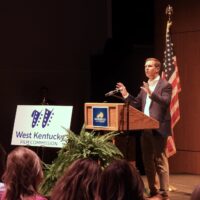Everyone gathers in close and finds a spot to make sure she is seen. Coats have been removed, likely due to the heat. Some clutch their purses while those toward the middle clasp hands. A few wear a ribbon pinned to their blouse, and those who wear hats do so with flair. An amateur photographer is in the group, too. She kneels down, points her box camera forward as the unseen photographer releases his shutter …
CLICK!
An adventure is captured.
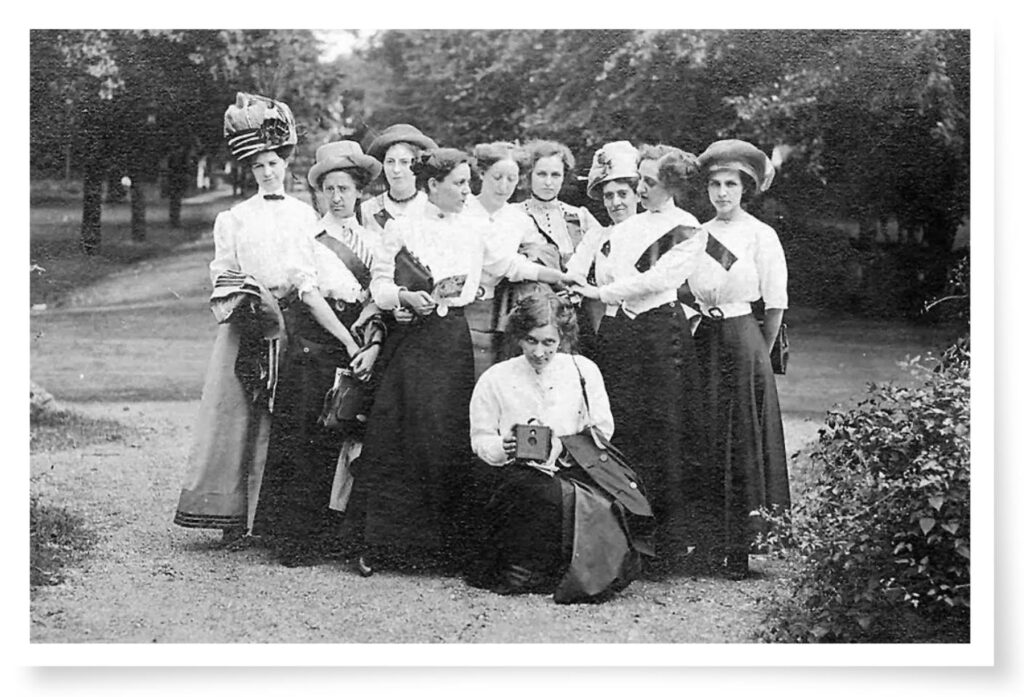
The first time I laid my eyes on this photograph, I was instantly intrigued and had so many questions. Who were these women? What are they doing? Where are they? What brought them all together? And where on Earth did they get their hats?
One of the best parts of my job with the museum (and of my life in Hopkinsville) is getting to work with Christian County Historian William Turner. Like so many of our community’s historic images, this one is in his collection. The back lists the name of one woman — Mattie Adams — and “New Era Trip, 1911.” That’s it. But with William’s help, I was able to go straight to my favorite place, the old newspapers, to discover the story behind this fascinating photograph.
The 10 women in this picture campaigned, marketed and promoted their way to earn a spot on a trip sponsored by the Kentucky New Era in the summer of 1911. For two months, from mid-May through mid-July, the New Era held a countywide contest to sell subscriptions to the newspaper. The county was divided into districts, and the woman who sold the most subscriptions in each district won an all-expense paid, week-long trip to Niagara Falls.
You’re looking at the contest winners.
At the time this picture was taken, these women were all between the ages of 18 and 27. They were all single. Half of them were employed outside of their homes. One had recently graduated from McLean College; another from Hopkinsville High School. They represented an interesting cross-section of the most popular ladies of the area at a time of great transition and change for women in this country.
Thanks to the newspaper coverage, we know their names, but I haven’t been able to put these names with most faces. They are Elizabeth McGee, Mollie Nichols, Lelia Robb, Ethel Renshaw, Maud Dawson, Hallie Clark, Rosebud Wood, Daisy Grace, Beulah Boyd, and Mattie Adams. The ladies were accompanied by chaperones Merriweather and Carrie Bacon on their trip. Mr. Bacon was serving as the city editor of the newspaper at the time.
Each woman had to be nominated in order to enter the contest. Any single or married woman was eligible so long as she was between the ages of 15 and 40. With the nomination came an initial 1,000 votes for the contestant. After that, subscriptions to the newspaper were solicited with 100 votes received for every $1 that was sold. Subscriptions to the daily New Era counted for more than those to the weekly, and new subscriptions earned more points than renewals. Extra points could be earned by folks returning coupons found in the newspaper during the contest period. All told, 74 women were nominated to participate, and they garnered a total of 541,330 votes by the contest’s end.
I can see why this promotional scheme got so much attention. The trip was extravagant and offered a jam-packed itinerary. The group departed Hopkinsville on the Illinois Central Railroad bound for Louisville on Monday, July 31, 1911. From Louisville, they made a quick stop in Cincinnati before heading north to spend two days in Niagara Falls and one day each in Cleveland, Buffalo and Toronto before returning home on Aug. 7. From amusement parks and fancy hotels to overnight steamer cruises and automobile tours, this must have been quite the adventure.
Upon arrival in Louisville, the ladies checked into the Louisville Hotel and headed to Fountaine Ferry Park. The amusement park didn’t disappoint; the group rode the roller coaster and the circle swing, laughed at themselves in the grotesque mirrors, and went to the vaudeville show. They boarded a train bound for Cincinnati the following morning where they had lunch at the Grand Hotel and transferred to Pullman cars for the overnight trip to Niagara Falls. They reached the city in time to take breakfast at the Temperance House, where they would stay for two nights.
The falls were the main attraction, but the city of Niagara Falls also proved to be a huge draw. With a thoroughfare bedecked with festoons of multi-colored electric lights, Falls Street boasted a pleasing promenade lined with the most fascinating shops, bazaars, and places of amusement. The ladies scored an exclusive tour of the state-of-the-art facility where Shredded Wheat Biscuits were manufactured. Described in a letter from the company to the New Era as a “show factory” as well as a manufacturing plant, the industry touted itself as the “finest, cleanest, most hygienic food factory in the world.” The group was given a special tour of employee areas including the roof garden, dining rooms, kitchen, rest rooms, library, locker rooms and baths.
The travelers departed Niagara Falls in observation cars for a trip over the Great Gorge Route to Lewiston, New York, where they boarded a steamer for a three-hour ride across Lake Ontario to Toronto. An automobile tour showcased the city’s finest attractions, and the evening was spent at Scarboro Beach, known as Toronto’s Coney Island.
After a night at the Walker House, the group enjoyed a day in Buffalo, before boarding the luxurious City of Buffalo steamer for an overnight cruise on Lake Erie. The newspaper described the boat as a “lake palace” that accommodated nearly 1,000 people. Quadruple decks, luxurious furnishings, and an interior that resembled a hotel made this evening one of the most memorable of the trip, I’m sure.
The opulent cruise delivered the ladies to Cleveland where they ate breakfast at The Colonial Hotel and spent the day sightseeing the city’s handsome homes and magnificent parks. Traveling once again on Pullman cars, the ladies made their way back home through Cincinnati and Louisville, reaching Hopkinsville on the evening of Monday, Aug 7, 1911.
Whew! What a whirlwind! I can only imagine the things these women had the opportunity to experience and the fun that they had. Oh, how I wish I could get my hands on the pictures that the woman with the box camera took along the way!
With most of my questions answered (aside from the proprietor of their hats), I turned my focus to who these women were. Here’s what I found:
Elizabeth McGee
At the time of the contest, Elizabeth was likely working as a teacher. Born in the southern part of the county, she was living with an uncle in town by 1910 and following the death of both of her parents. After attending classes at Western Kentucky Normal School, she taught in Marion before moving to Ardmore, Oklahoma, in 1918. That’s where I lost track of Elizabeth. She was the most elusive of the group.
Mollie Nichols
At age 27, Mollie was the oldest of the winners. In 1911, she was employed at Frankel’s Busy Store on South Main Street. She married John Gillihan the following year. He worked as a bookkeeper for a tobacco firm, and she continued to work at a dry goods store. They had one son. She died in Hopkinsville in 1973.
Lelia Robb
(Far right) Lelia sold more subscriptions and was the top vote-earner with 59,640 votes. By coming in first place, Lelia earned her mother, who nominated her, $15 in gold. Her father worked as a mechanic and died in 1909. At the time of the contest, Lelia had just graduated from Hopkinsville High School where she was listed as “Miss Demure” in the yearbook. In 1920, she lived with her mother and brother on Belmont Street and was working as a typewriter at a dry goods store. She married William D. Mann, an attorney, and they moved to Los Angeles, California. She died there in 1979.
Ethel Renshaw
The daughter of a liveryman, Ethel (or Ethyl, as spelled on her tombstone) does not appear to have worked outside the home. She married Glyde Cox, a shoe salesman, between 1926 and 1930, and they lived with her sister and brother. His obituary listed him as a retired farmer in 1965. She died in 1971.
Maud Dawson
Maud grew up in the southern part of the county, one of six daughters of Peter and Lucy Dawson. She worked as a teacher and served as the postmaster at Herndon for a number of years — both before and after she married Will Keatts, a popular farmer, in 1913. The couple had two daughters. Maud died in 1918 at the age of 32 following surgery for gallstones.
Hallie Clark
Hallie was a well-respected educator who taught at Fruit Hill, Concord and Dogwood before placement at Casky where she would become the principal. In 1918, she was appointed the office deputy by the Christian County sheriff and eventually as the Deputy County Court Clerk. She married Paul Williams, a retired hotel manager, in 1948 when she was almost 60 years old. She died in 1968.
Rosebud Wood
Yes, her name was definitely Rosebud. Her father James B. Wood was a farmer, and two servants lived in their home in 1900 when Rosebud was 12 years old. In 1915, she married Waller Clements Sellers, and their daughter Mary was born in Hopkinsville in 1917. It appears her husband served in World War I. They divorced, and he remarried in 1920. Rosebud moved to Dallas, where she is consistently listed as a widow (even though her ex-husband was very much alive). The single mother worked as the matron at the Salvation Army Girls Protective Home, at a Working Mothers Home, and at a children’s nursery. She died in 1950 in Arizona and is buried in San Angelo, Texas.
Daisy Grace
Daisy represented District No. 8 — the territory outside of Christian County. From Kirkmansville in Todd County, Daisy was an accomplished pianist who graduated from McLean College in Hopkinsville with her B.S. in Music in the spring of 1911. She performed E. MacDowell’s “Hexentanz” or “Witch’s Dance” at her graduation ceremony. Because the internet can be a fascinating thing, you can listen to someone else playing this mind-blowing piece. She worked as a music teacher before marrying Walter G. Trice in 1919. They lived with his family on South Main Street next door to the house commonly known as “the castle” before moving to West 15th Street. He would eventually become a part owner of the Hopkinsville Stone Co. They had one son and seven grandchildren. Daisy died in 1980.
Beulah Boyd
Receiving the second highest vote count, Beulah was working at Stadelman’s Meat Shop, likely as a bookkeeper, when this picture was taken. Her sister Lillian worked as a “telephone girl” and was one of the women that Night Riders pulled from the Cumberland Telephone and Telegraph Office on Ninth Street during their raid on Hopkinsville in 1907. In 1917, Beulah traveled with a local contingency to the Nashville Grand Opera to hear local star Riccardo Martin perform. She graduated from the HHS Commercial Class later that year. She married William Cowherd in 1918, and they raised three children and farmed along Russellville Road. Beulah passed away in 1947.
Mattie Adams
(Second from right) The reason we have this picture at all! Mattie grew up in the Church Hill area of the county on Cox Mill Road. The daughter of farmer James Monroe and Mary Sivley Adams, Mattie shows up frequently in the newspaper for her attendance at parties. She married Walter Melrose Wood, a widower, in 1945 when she was in her mid 50s. Wood was an undertaker and funeral director who opened Criss, Wood, & Fuqua, the city’s first funeral home. Mattie’s obituary listed her as a retired nurse. She died in 1989 at age 98.
There they are! The ten most popular women in Christian County in 1911.
In all honesty, I really wanted these women to be outspoken, brazen suffragists from Hopkinsville when I first saw the picture. I wanted them to be actively challenging the status quo and protesting for equal rights. I imagined them stepping away from this pose, picking up banners declaring “Votes for Women,” and joining the ranks with Alice Paul and Ida B. Wells-Barnett in a massive parade. I created a narrative in my head that didn’t fit … at least not totally.
But these women were revolutionary. They were powerful and challenged the status quo in their own ways. They lived at a time when women were gaining more freedom. They were educated and talented. Most of them held jobs outside of the home. A few completely supported their families on their own. They were independent in ways that women had not really known yet.
And they were bold and confident enough to participate in a vast contest, seek the support needed to win, board a train, and go on the adventure of a lifetime.
This picture hangs in the Pennyroyal Area Museum as a reminder of all the women who have lived, worked and contributed to this community. These women gracefully broke barriers and ushered us into a new understanding of women’s roles in society.
And they did it all while wearing amazing hats.
Alissa Keller is the executive director of the Museums of Historic Hopkinsville-Christian County. She’s a graduate of Centre College with degrees in history and English and of Clemson University/College of Charleston with a master’s degree in historic preservation. She serves on the Kentucky Historical Society and the Kentucky Museum and Heritage Alliance boards.

